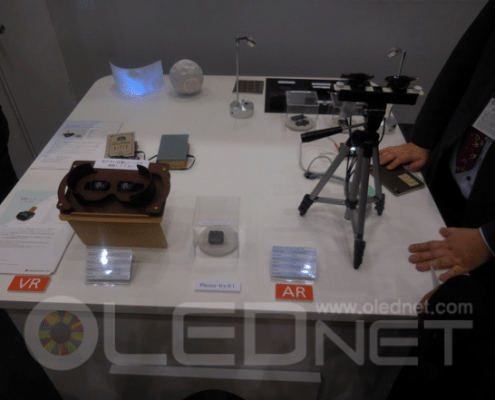PMOLEDとマイクロOLED、ウェアラブル機器市場で真価を発揮する
東京ビッグサイトで1月17日から開催中の第4回ウェアラブルEXPOで、多くのメーカーがOLEDウェアラブル機器とOLEDパネルを展示し、来場者の注目を集めた。特に今回の展示会ではPMOLEDとマイクロOLEDを採用したウェアラブル機器が多数展示され、OLEDの無限な発展可能性を再確認できる機会となった。
まずColorLink JapanはマイクロOLEDを採用したVR機器とAR機器を披露した。マイクロOLEDはOLEDパネルをマイクロサイズまで抑え、小さいながらも高解像度が実現できるパネルである。ColorLink JapanのVR機器に採用したマイクロOLEDは、0.7インチサイズのFHD解像度で、関係者はマイクロOLEDの採用によって、コンパクトで希少性のあるVR機器を製作することができたと述べた。

<マイクロOLEDを採用したColorLink JapanのVR機器とAR機器>
FitbitとiWOWNfitはPMOLEDを採用したスマートバンドを展示した。PMOLEDはスイッチング素子のTFTが採用されていないパッシブマトリクスOLEDのことを意味し、高解像度が必要な機器よりは、数字や文字を表す低解像度対応機器に多く採用されている。2社の関係者はPMOLEDの採用によって消費電力が大幅に削減されただけでなく、OLED価格も大きく低下しているため、十分な価格競争力を備えていると説明した。
一方、OLEDパネルメーカーも多くのウェアラブル機器用OLEDパネルを展示した。1997年に初めてFM文字放送受信用モノカラーPMOLEDを量産したPioneerは、PMOLEDやこれを活用した様々な機器を披露し、来場者を魅了した。PioneerはPMOLEDを採用したBluetoothスピーカーとスマートウォッチ、AR機器を多く披露し、PMOLEDを中心として事業を多角化する目標を明らかにした。

<PioneerのPMOLEDパネルとAR機器>
RiTdisplayもPMOLEDを採用したウェアラブル機器とパネルを多数披露し、注目を集めた。RiTdisplayの関係者は「AMOLED市場は既に韓国に先取りされてしまい、生産力と価格競争力が劣るのは仕方ない。しかし、PMOLEDを用いることで、AMOLEDに比べ低コストでもカスタマイズすることができるので、ウェアラブル機器市場においては競争力がある」と語った。スマートバンドはスマートウォッチやモバイル機器よりppiが低くても問題ないため、この市場を積極的に攻略することを明らかにした。

<RiTdisplayのPMOLEDパネルと応用機器>
このようにモバイル機器とTV市場をリードしているAMOLED以外にも、PMOLEDとマイクロOLEDなどの様々な方式のOLEDがウェアラブル機器へ本格的に採用され、その勢力を増している。さらに活用の幅が広がっているOLEDの未来が期待される。



